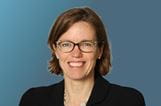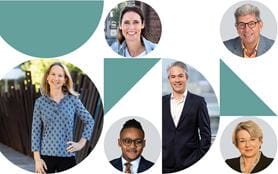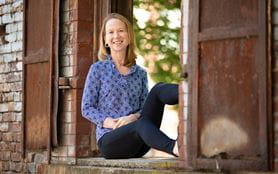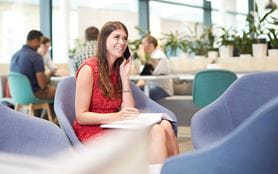Hybrid ways of working: a new normal
Related people
Headlines in this article
Related news and insights
Blog Post: 20 June 2022
Blog Post: 05 January 2022
Blog Post: 12 October 2021
Publications: 08 March 2021
a new tomorrow?

If the Covid-19 lockdown has shown one thing, it’s that it’s easier to get out of the office and work from home than to get back into the office.
That’s the view of Patricia Rogers, Chief Operating Officer of IT & Shared Services, who says A&O has done an “amazing amount of work in a sustained fashion” looking after its people through this difficult period.
The 16 months up to July 2021 did a lot to progress the culture of remote and flexible working across A&O; with the return to some offices in September 2021 came the opportunity to preserve the best of that experience.
In many ways, the pandemic accelerated changes that were already happening at A&O with, for example, the use of “seamless” technology and initiatives such as iFlex flexible working arrangements.
It’s a work in progress, but with internal research showing that hybrid arrangements encompassing office and remote working are beneficial to both A&O and the individual, momentum is building, with workstreams looking closely at what’s best for individuals, A&O and our clients.
Patricia says experience underlined the need “to structure the return to office working very carefully; certain aspects needed to be addressed.
“When we discussed what these aspects were – how and where we work, the tools we need to carry out our work, maintaining security and confidentiality – they fell neatly into six categories, which gave us our workstreams.”
They are:
- Employee life cycle;
- Place;
- Technology;
- BD & CRM – Client engagement;
- Client confidentiality and data security;
- Physical security.
Patricia points out this framework was designed for the UK offices but would be “eminently usable” should other offices choose to use it. “All our people are trying to move in the same direction in respect of hybrid working.
Policies fit for purpose
‘Employee life cycle’, managed by Global HR Director, Sasha Hardman, is about “how we bring hybrid working to life”. It has been looking at policies to make sure they’re fit for purpose in the new working environment, to change them if necessary, and to make sure people managers have the guidance and tools they need. Sasha says: “Working in a hybrid way will be challenging.”
Paul King, Head of Hospitality Services, and Rachel Labo, Business Senior Manager, manage the second stream, ‘Place’, which aims to make sure the firm’s offices are supporting the new hybrid way of working and which supports the firm’s sustainability objective.
Rachel says the team is planning to build an experimental space within the London office for partners and staff to trial different ways of working. Data and feedback from this ‘Future Space’, which will go live in summer 2022, will inform space planning for the future.
Patricia says Belfast provides a good case study for the creative use of space. The office had just completed an 18-month project to realign its office space to accommodate an “agile” working environment prior to the pandemic. Surveys before lockdown showed it was working as hoped, and made moving into lockdown “very simple”, she says. “From a practical perspective, getting back will be easy as well.”
Efficiency is a watchword for the ‘Technology’ workstream, managed by Simon Wagstaff, Global Head Tech Services and Eric Theboul, IT Head, Europe and Africa. The key element, says Simon, is that “we should all be able to have a seamless working experience wherever we are”.
The same must be true for clients. Katharine Taylor, Global Head of FIG, managing the ‘BD & CRM’ workstream, says the focus is on being “flexible and adaptable for our clients – the client experience must be seamless”.
How close is this to happening? “Close,” says Patricia, “but technology is always evolving – you solve one problem and something new will pop up.”
Challenge lies in security Technology impacts the ‘Client confidentiality and data security’ workstream, where Chief Information Officer Mark Jones is directing efforts focused on cybersecurity. The world expects more to be done electronically, and procedures such as signing documents are getting better and better. The challenge lies in ensuring client – and our own – data remains secure when people are working from myriad locations, using all systems.
A final workstream, managed by Ed Clark, is looking into the ‘Physical security’ of our London office, whose use is expected to change as hybrid working evolves.
“In a nutshell,” says Patricia, “what we’re trying to do is address how employees work, giving them the tools, whether HR or technology, to do their jobs and engage with clients in a way that suits them best while making sure data remains secure.
“Our workstreams are evolving; I think they address all the right things and are being put to the test as we have re-occupancy of our buildings.”
Redefining success
A&O people, like so many in professional services, are increasingly choosing to structure careers to better suit their lives, redefining success and using flexibility to find a better work/life balance.
As Sasha Hardman notes, time in the office is important “in order for teams to be cohesive and for people to learn and develop” because everyone has a responsibility to help each other. A&O is leaning toward a hybrid arrangement of time in and out of the office on a 60:40 ratio.
“Trust underpins this kind of working arrangement,” says Sasha. “We know we ask a lot of our people, so in return we have to trust them to deliver. People have different styles of working and priorities change, so there has to be give and take.”
Agile and flexible working are two points on a common scale. “Agile is the informal end,” says Sasha, where, on an ad hoc basis, people have flexibility within their working hours to respond to whatever is going on in their lives.
Flexible working, at the more formal end of the scale, allows for people to work fewer days each week, for example, or to take extra annual leave, perhaps during school holidays.
But it’s not just for parents, Sasha says, and not just for lawyers. “We’ve had examples of an associate taking time out to train for the Paralympic Games, and people having flexibility to study something completely different – whatever the motivation, if it’s something we can make work on both sides, then let’s have a discussion about it.”
Partner Denise Gibson takes Januarys off through an arrangement to build in more downtime across the year. “It’s a quieter month for my practice and means that, while my children are pre-school age, we can get back to Australia to spend time with family. Once my kids start school, I’ll think about the next solution. What works for people will change at different stages of life.”
There are considerations, however, about the right time to make such arrangements work.
As Sasha points out, during the junior stages of careers, learning, developing technical skills and building networks are all crucial, so it’s important to consider the impact of hybrid and other working arrangements.
“It doesn’t mean it’s impossible, but in any role the key is to think carefully about what will work for you, your team and your broader career.”
It’s also important to remember that these arrangements don’t have to be long term. “Life changes and careers change – the important thing is to ensure lines of communication are open and to be honest on both sides about how things are going.”
We know we ask a lot of our people, so in return we have to trust them to deliver.
Sasha Hardman
“Joy of seeing each other”
Senior Partner Wim Dejonghe has no doubt about “the huge benefits that come from the simple but very important joy of seeing each other and being together in the office.” Without the office, he observes, “some of the fun has gone out of work.”
Writing in blog posts, he said: “In the last 12 months we’ve had to learn a whole new range of habits – and have done so with remarkable success. Now we have the chance to find a middle road, combining the best of the old and the best of the new.”
He warned that adopting hybrid working “will be tricky at times.” Arrangements will differ office to office, based on local laws, customs and ways of living as well as ensuring we can respond to our clients’ needs.
“If we are careful and clever about it, we can devise a new way of working that will foster greater and more effective collaboration while helping to make A&O the diverse and inclusive place we all want it to be as well as maintaining its position as one of the world’s leading law firms.”

Around the A&O network, offices rose to the lockdown challenge of maintaining some of the buzz, inspiration and energy of the office, and looking after colleagues’ health and wellbeing.
Amsterdam’s innovative talk show proves a hit
Amsterdam called its internal engagement campaign Working Apart Together (WAT). Launched in October 2020, it included surprise gift deliveries, interactive group activities, a newsletter and a popular monthly talk show.
The 45-minute lunchtime programme, presented live from the Amsterdam office, invites guests to introduce business issues and topics of interest. Managing partner Justin Steer and senior partner Brechje van der Velden are strong supporters, and alternate as co-host, alongside Michele Zwarts, senior manager in Communications and PR.
“The focus is on promoting A&O’s culture, human connection and enforcing a sense of pride in the firm,” says Dominique Van Dreven. “Feedback has been so positive that the talk shows look set to continue post-Covid.”
The talk show format has been successfully applied to external webinars, client events and explainer videos on issues such as data protection and hostile takeover defence.
Madrid’s virtual seminars a hit with clients
Good communication was key to A&O Madrid’s “reinventing ourselves” successfully. Externally, the virtual seminars of the A&O University for clients proved a success. Rather than holding sessions in the auditorium, as envisaged when the university was created, it went online, starting with sessions on arbitration in June 2020, corporate in October 2020, banking in March 2021, and restructuring at a later date.
Internally, the A&O Life weekly newsletter distributed through the first half of 2020 helped hold the team together. “The cover was always a picture of one of us at home,” says Ana Isabel Delgado, marketing manager. For health and wellbeing, the office offered virtual training and “Smart running” guided by professional personal trainers.
While the annual alumni event was not possible this year, Madrid sent its alumni reusable water bottles to reinforce the message that keeping in touch with them was as essential as water itself.
Bratislava colleagues adapt to hybrid model
To accommodate hybrid working, Bratislava carried out a partial redesign, which involved converting some offices to a shared desk arrangement, and creating collaboration spaces. Eva Sednickova, HR and office manager, says colleagues “adapted to the new situation” of virtual internal and client meetings. “We also held our first virtual hearing which took two weeks.”
New space age in New York and LA
The new Los Angeles office opened in June 2021 with space for all 12 people to work safely. Meanwhile, the New York office is undergoing reconfiguration to make it fit for the future as our people return to a mix of office-based and home-based working.
“The space is still configured to suit partner/PA ratios of years ago,” says Patricia Meinen, Head of Business Services, “and 40% of colleagues also share offices.” The main considerations for the renovations were to be prepared for the future, should another variant cause problems, to allow for social distancing and to use the space more efficiently.
Jakarta makes team wellbeing a priority
A number of initiatives at the Jakarta office were aimed at supporting the wellbeing of our people in this new working world. As the end of 2021 approached, colleagues remained in full work-from-home mode. Project manager Abdelon Salimi says a return to the office might start in early 2022, on a two-group rotation system.
Counselling was extended to cover not only career-related matters but also specialised support in personal wellbeing. From July, Covid-19 Home Services treatment has been available for Jakarta colleagues and their families “to give our employees peace of mind”.
“We launched an employee recognition platform to sustain the culture of giving recognition for a job well done – particularly critical in this time of virtual working,” says Abdelon.






